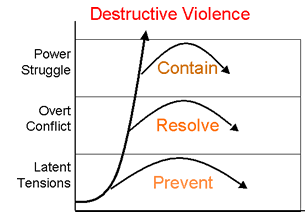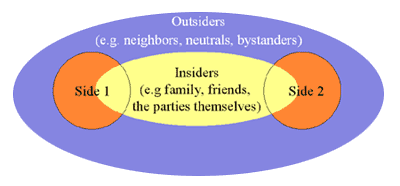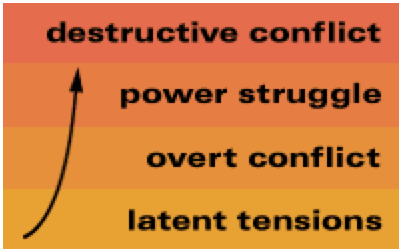Teacher – Give People Skills to Handle Conflict
Sometimes people fight simply because they know no other way to react when a need is frustrated and a serious difference arises. By helping people learn new values, perspectives and skills, we as Teachers can show them a better way to deal with differences.
Delegitimize Violence
A first step is to teach that violence solves nothing:
- Before he began his talk to a room full of teen-age boys, Michael Harrington asked three of them to hop about on one leg. He wanted the boys to know what the last 25 years have been like for him. Harrington lost his right leg in the Vietnam War. When he returned home, Harrington told the hushed teen-agers, he would sometimes take his anger out on others. The only other sound in the room came from the clicking of Harrington’s aluminum crutches. “Physical force has gotten me nowhere,” he said. “Talking is the way. Negotiating is the way. Violence isn’t.”
- The Veterans Education Project in Massachusetts deploys veterans of America’s wars such as Harrington to schools around the state. By telling their stories about how violence has affected them personally, the veterans get teenagers to talk about the violence in their own lives. “We explain that once you learn to respond violently on the street, it’s hard to go home and be a caring son, boyfriend, or father,” explains one veteran.” That really gets to them because these guys want to be good fathers. Most of them never had one.”
- The vital importance of such messages from the older to the younger is underscored by Tom Winstone, an Irish Protestant convicted of murdering two Catholics in 1974. After his release from prison, Winstone turned to helping Protestant youths stay away from violence: “When I was 15, 16, 17, I had no one to say, ‘I went up a certain path; it didn’t work; and it was wrong.'”
Teach tolerance
The alternative to violence is tolerance. Tolerance does not mean agreeing with the other or remaining indifferent in the face of injustice but rather showing respect for the essential humanity in every person. Every day, each of us has the opportunity to teach children to respect others and their beliefs and practices, if only by trying to model the behavior ourselves.
Today, tolerance is beginning to be taught in schools around the world; age-old prejudices and stereotypes are being challenged.
- In Northern Ireland, most schoolchildren are exposed to a program called “Education for Mutual Understanding” to ensure that they learn about the traditions, history, and culture of both the Protestant and Catholic communities.
- The School for Peace at Neve Shalom/Wahat al-Salaam, a Jewish-Arab community in Israel, has organized “encounter” workshops and summer camps for over sixteen thousand Arab and Jewish children.
- In the United States, more than fifty thousand schools use a program on “Teaching Tolerance.” Children in Boston public schools learn perspective-taking and empathy by writing their personal stories and reading them aloud in class.
If peace proves elusive for this generation of adults, these programs inspire hope for the next one.
On an even larger scale, television and radio have enormous potential as tools for teaching tolerance and respect.
- The children’s television program Sesame Street, now shown in a hundred countries around the world, illustrates friendships across groups. The Canadian version shows English-speaking children playing with French-speakers; in the Dutch version, Dutch, Moroccan, Turkish, and Surinamese children interact. The young viewers, research suggests, are more likely to reach out on their own and form friendships across differences.
- In Burundi, torn by ethnic violence, radio soap operas feature Hutu and Tutsi people living alongside each other, carrying on friendships, and intermarrying.
Teach joint problem-solving
Tolerance is not enough; people need practical ways to deal with the everyday tensions so that they do not escalate into harmful conflicts and violence.
- In thousands of elementary and high schools all across the United States, programs have been established to teach children the vital skills of problem-solving, communication, empathy, anger management and conflict resolution. To the three R’s of Reading, ‘Riting, and ‘Rithmetic, a fourth R has been added: Resolution. “Why don’t we try it this way?” children learn to ask. Through role-playing and discussion, they practice how to react in potentially volatile situations and to think twice about little things that could turn into nasty fights.
- Children can also teach their peers. Four hundred youths from Detroit, including gang members and affluent teenagers, went through intensive training in conflict resolution at the Martin Luther King Center in Atlanta, then returned to their schools and proceeded to teach twenty-eight thousand high-schoolers.
One day there may be universal education for children in joint problem-solving, anger management, and conflict resolution. Just as physical education has become a standard part of the curriculum, so too may social-emotional education.
Adults can learn problem-solving too:
- In the midst of a major reorganization of a hospital in St. Paul, Minnesota, conflicts among co-workers soared. Employees, labor leaders, and managers got together and organized a skills program called “Communication and Conflict in the Workplace” to teach employees how to handle conflict, stress, and interpersonal relationships with co-workers. Taught by fellow employees who volunteered their time, the program measurably improved productivity and patient quality of care as well as the workplace environment.
Courses such as this on collaborative negotiation skills are multiplying in universities, in the workplace, and in community centers.
Everyone, everywhere is a potential learner and Teacher of ways to deal with differences. The goal of teaching is to help create a culture of collaboration and constructive conflict, a genuine “co-culture.”
Resources
- Program on Negotiation at Harvard Law School
- Institute for Conflict Analysis and Resolution at George Mason University
- University of Colorado Conflict Research Consortium
- National Multicultural Institute
- United States Institute of Peace
- Conflict Resolution Resource Center
- Ask ERIC
- National Coalition Building Institute
- Educators For Social Responsibilities
Brief bibliography
- Bodine, R. and D. Crawford (1997). The Handbook on Conflict Resolution Education: A Guide to Building Quality Programs in Schools. San Francisco: Jossey Bass.
- Girard, J. and S. Koch (1996). Conflict Resolution in the Schools: A Manual for Educators. San Francisco: Jossey Bass.
- Godine, R. (1994). Creating the Peaceable School: A comprehensive Program for Teaching Conflict Resolution. Research Press.
- Landry, E., D. Kolb, and J. Rubin (1991). Curriculum for Negotiation and Conflict Management. Cambridge, MA: PON Books.
- Ury, William (2000). The Third Side:Why We Fight and How We Can Stop. New York: Penguin.




